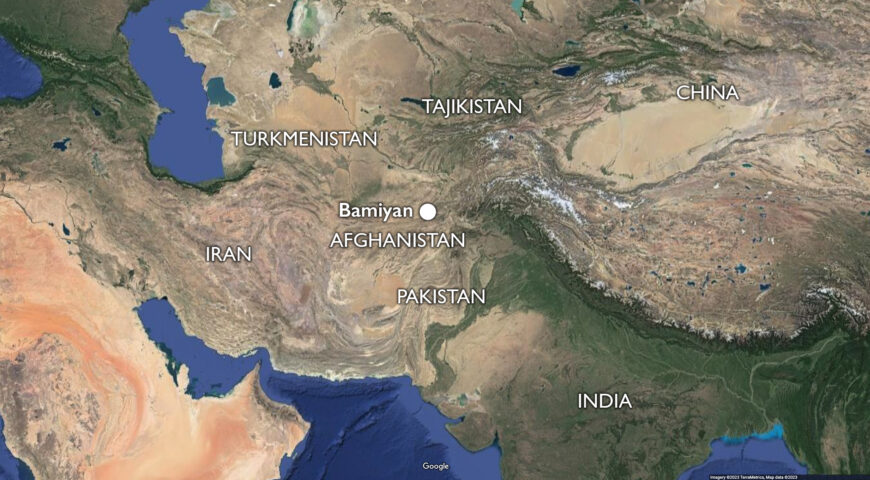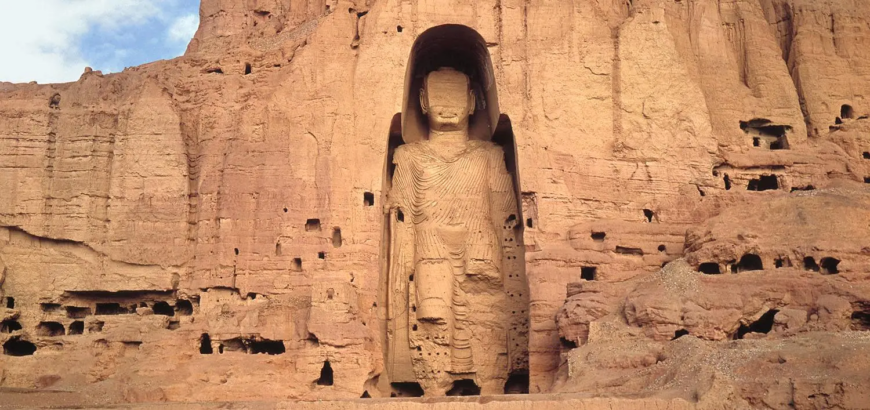
West Buddha surrounded by caves, c. 6th–7th century C.E. (Bamiyan, Afghanistan), stone, stucco, paint, 175 feet high, destroyed 2001 (photo: Afghanistan Embassy) © Afghanistan Embassy
Prior to their recent destruction, the 6th-to-7th-century, rock-cut Buddha sculptures in the Bamiyan Valley of central Afghanistan were considered the largest in the world. Known collectively as the Bamiyan Buddhas, the two monumental sculptures have amazed both Buddhist and non-Buddhist visitors for more than a 1,000 years. Like many of the world’s great ancient monuments, little is known about who commissioned the Bamiyan Buddhas or the sculptors who carved them. However, their very existence points to the importance of the Buddhist faith and the Bamiyan Valley during this period.
Buddhism along the Silk Route
Bamiyan is located between the Indian subcontinent (to the southeast) and Central Asia (to the north), which made it an important location close to one of the most important branches of the Silk Route. The Silk Route was an ancient series of linked trade routes that connected China to West Asia and Europe and carried both material wealth and ideas. Bamiyan’s central location along the Silk Route, along with its fertile plains amid harsh terrain, made it an ideal location for merchants and missionaries to stop during their travels. Many of the missionaries and merchants in this area during the middle of the 1st millennium were practitioners of the Buddhist faith. Buddhism had long been an important religion in the region, having been introduced during the early Kushan period.
Buddhism spread, in part, because it was not location specific. Believers did not need to worship at a particular temple or at a particular site as part of their practice. Worship could take place anywhere and at anytime. This freedom resulted in the emergence of Buddhist cave architecture throughout Asia. Indeed, if one visits Bamiyan today, one will see nearly 1000 Buddhist caves carved along 1300 meters of cliff face. [1] It is against this backdrop of carved caves that the two monumental Buddha images were carved.
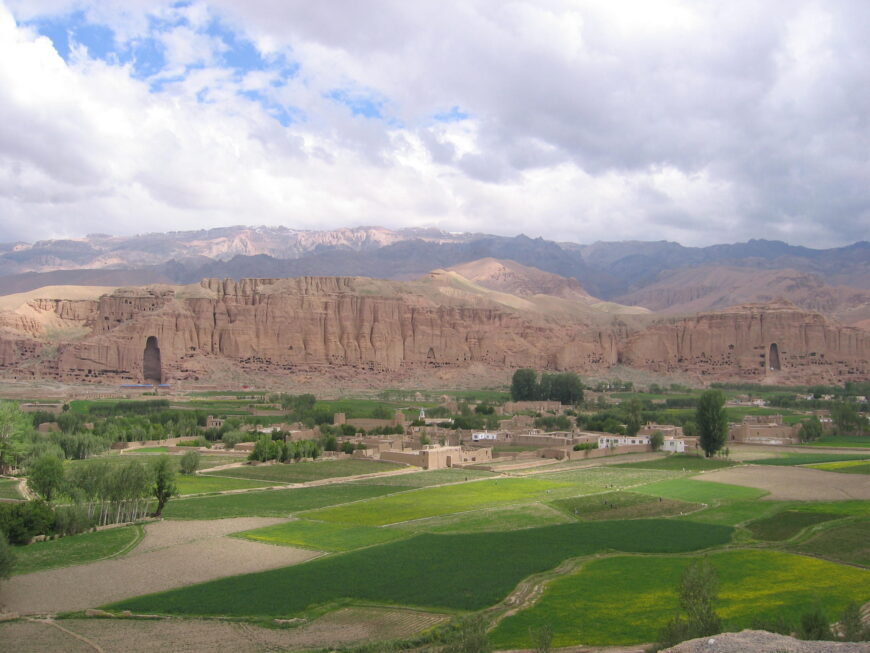
Landscape and archaeological remains of the Bamiyan Valley (photo: Graciela Gonzalez Brigas, CC BY 3.0 IGO) © UNESCO/G. Gonzales Brigas
Monumental Buddhas
Prior to their destruction in 2001, two monumental Buddha sculptures could be seen carved into the cliff facing the Bamiyan Valley. The larger of the two figures, located on the western end (on the right in the photo above), measured 175 feet in height. The art historian Susan Huntington has argued that it represented the Buddha Vairochana. The smaller of the two monumental statues, located to the east, depicted the Buddha Shakyamuni. This figure was also enormous and measured 120 feet in height.
Both images were carved into niches of the cliff side in high relief. The area near the heads of both Buddha figures and the area around the larger Buddha’s feet were carved in the round, allowing worshippers to circumambulate. Circumambulation, which is the act of walking around an object such as a stupa (a reliquary mound) or an image of the Buddha, is a common practice in Buddhist worship.
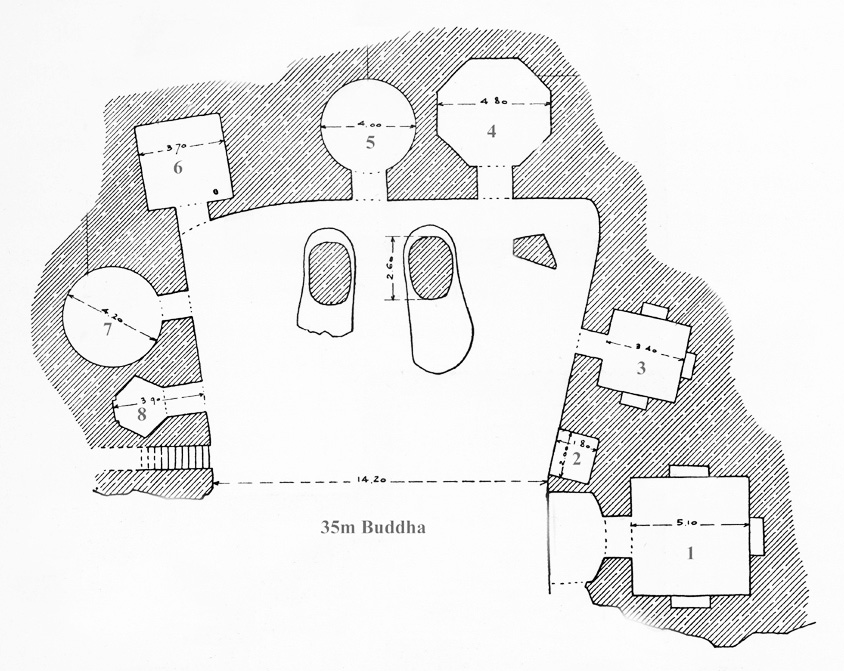
Plan of larger Buddha showing feet carved in the round and smaller cave chapels. André Godard, Y. Godard, and Joseph Hackin, Les Antiquites Bouddhiques de Bamiyan (Paris and Brussels: les Editions G. Van Oest, 1928), figure 18
The two large Buddha images reflected the international environment of the Bamiyan Valley and were influenced by the art and cultures of India, Central Asia, and even ancient Greek culture. For example, both Buddhas wore flowing robes and have been described as having wavy curls of hair. This hairstyle and the flowing drapery are elements rooted in early Gandharan Buddhist imagery that combined Hellenistic Greek traditions of representation with Indian subject matter. [2]
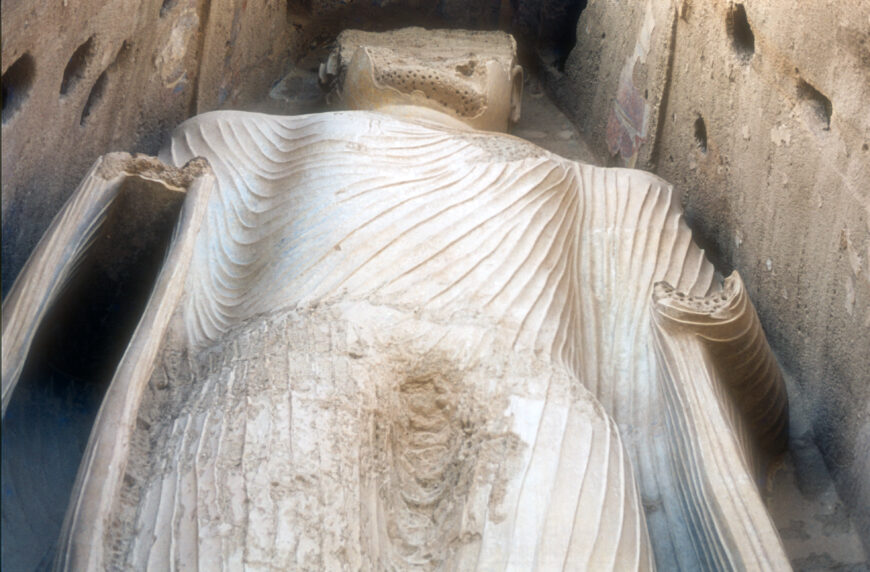
East Buddha (detail with drapery in 1975), c. 6th–7th century C.E. (Bamiyan, Afghanistan), stone, stucco, painted, 120 feet high, destroyed 2001 (photo: Pierre Le Bigot, CC BY-NC-ND 2.0)
Much of what we know about the monumental Buddha sculptures comes from the Chinese monk Xuanzang (Hsuan-Tsang) who traveled to Bamiyan in 643 and documented his travels in the text The Great Tang Records of the Western Regions (Da Tang Xiyu Ji). As the earliest text describing the Buddha images, Xuanzang’s writings provide us with remarkable descriptions of the sculptures and the vibrant communities that inhabited the region. He wrote:
When merchants coming and going happen to witness visions of heavenly deities, whether as good omens or as predictions of disaster, they worship the deities to pray for blessedness. There are several tens of monasteries with several thousand monks, who follow the Hinayana teachings of the Lokottaravada school. To the northeast of the city, there is at a corner of the mountains a rock statue of the Buddha standing, one hundred forty or fifty feet in height, a dazzling golden color and adorned with brilliant gems. To the east there is a monastery built by a previous king of the country. To the east of the monastery there is a copper statue of the Buddha standing, more than one hundred feet tall. It was cast in separate pieces and then welded together into shape.
[3]
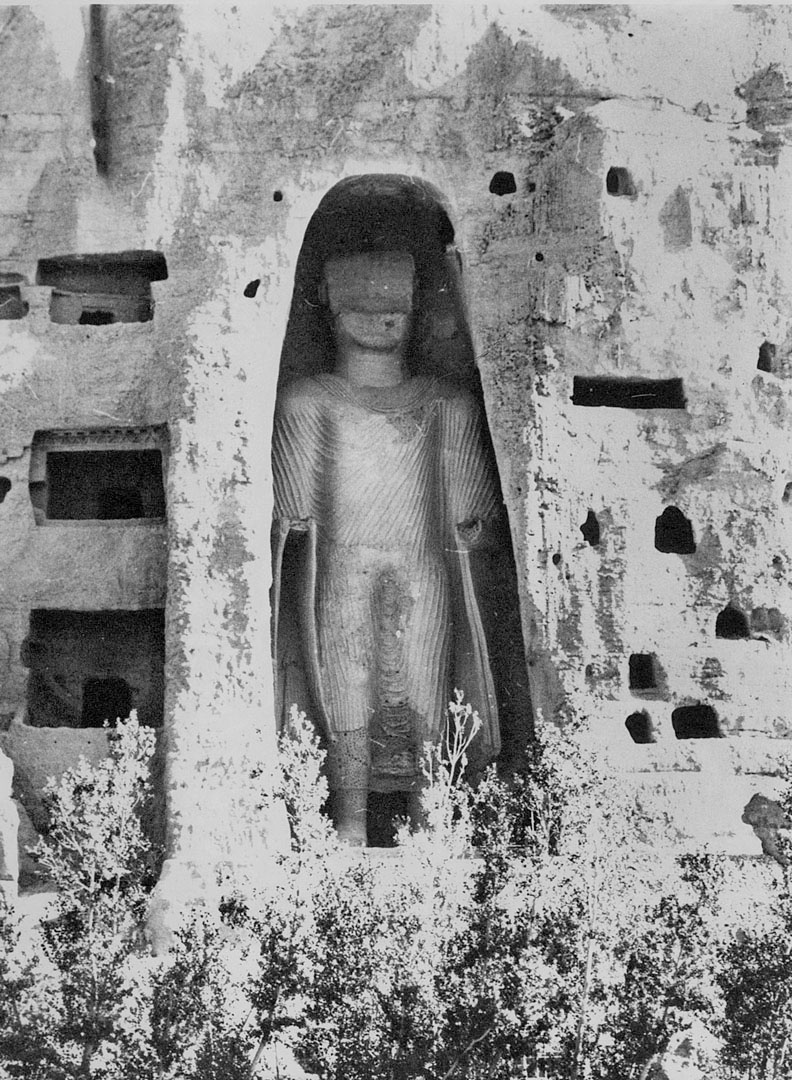
East Buddha, c. 6th–7th century C.E. (Bamiyan, Afghanistan), stone, stucco, painted, 120 feet high, destroyed 2001 (photo: © Dr. H. Crane)
Xuanzang’s descriptions of the Buddhas provide us great insight into not only what they might have looked like in the 7th century but also how they were engaged with the community around them. Perhaps most surprising to our modern experience with Buddha imagery is that the monumental rock-cut sculptures are described by Xuanzang as being adorned with metal, color, and gems—not stripped down as we often see them in museums and galleries.
Scholars agree that both images were covered in pigments of various hues so that they appeared to be made of metal and other materials, but that they were not cast entirely of “copper” as Xuanzang suggests of the smaller Buddha image. However, scholars such as Deborah Klimburg-Salter have argued that both of the monumental Buddhas’ faces were constructed of masks made of wood clad by a thin layer of brass, which were inserted onto ledges that appeared above the lower lips of both images. [4] Finbarr Barry Flood argues that the cuts to the faces were a later iconoclastic act. [5]
While there is debate over the material and treatment of the Buddha’s faces, we know that pigments were applied to the stucco that covered the stone surfaces of the sculptures. Stucco helped to even out the textured rock surface. One can imagine what a powerful impression these monumental Buddhas would have made on passersby and worshippers.
Backstory
In 2001, Mullah Omar ordered Taliban forces to demolish the Bamiyan Buddhas. As reported in The Guardian, the destruction took several weeks, and the two figures “proved remarkably solid. Anti-aircraft guns had little effect, so the engineers placed anti-tank mines between their feet, then bored holes into their heads and packed them with dynamite.” Only outlines of the figures and a few details now remain in place; fragments of them (including about 30% of the smaller Buddha) are piled nearby.
The Taliban’s direction to destroy the Buddha images was motivated, in part, by the group’s extreme iconoclastic campaign as well as their disdain for the fact that money from Western countries was being spent on protecting the images while there was an intense and growing need for humanitarian aid in the region. It was also unquestionably an act designed to gain global media attention, as video and photographs of the destruction circulated quickly and were seen all over the world.
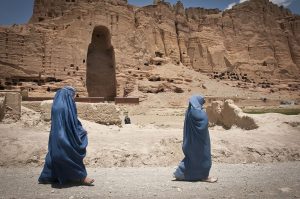
Two women walk past the site of the Buddhas of Bamiyan, June, 2012 (photo: Sgt. Ken Scar)
Bamiyan is now listed by UNESCO as a World Heritage Site in Danger, and debates over how to restore the site connect to both national and international issues around what constitutes proper preservation, interpretation, and remembrance at former sites of violence. The questions that must now be answered about Bamiyan are: how do we preserve what is left at the site from further destruction or deterioration? How do we do so in a way that takes into account the needs and desires of the local, national, and international communities for whom this site holds meaning? And how do we properly memorialize the tragedy of the Buddhas’ recent destruction?
The Taliban’s claim that destroying the Buddha sculptures was an Islamic act is belied by the fact that Bamiyan had become predominantly Muslim by the 10th century and that the sculptures had up until 2001 remained a largely intact. Distinct, non-Buddhist local traditions had grown up around the two sculptures, with a legend characterizing them as doomed lovers who had pledged to live out their commitment to one another by standing together in stone for eternity. “Local people had completely forgotten they were figures of the Buddha,” said the head of historical monuments in Bamiyan province.
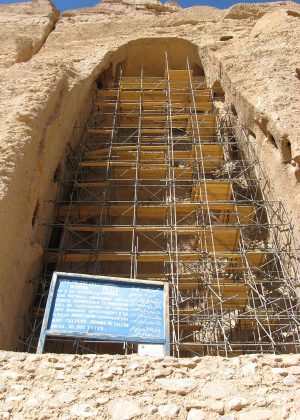
Scaffolding for reconstructing the Buddha of Bamiyan (photo: Tracy Hunter, CC BY 2.0)
Preservation efforts by an international team have been ongoing since 2001. The porous sandstone that makes up the site makes it vulnerable to quick erosion, and the niches, the cliff face, and the surrounding caves have needed to be shored up with props and grouting to prevent collapse. There has also been an ongoing debate over how and whether to reconstruct parts of the site. One proposal, backed most heavily by the German arm of ICOMOS (the International Council on Monuments and Sites, an international organization that supports preservation and monument protection) supports using the original fragments along with new material to reconstruct the smaller Buddha figure. Other experts oppose this idea, saying that the niches ought to be preserved as empty memorials to the sculptures’ violent destruction, similar to other sites like the Genbaku dome in Hiroshima or the Gedächtniskirche in Berlin. In 2015, two Chinese documentary filmmakers used 3-D technology to project holograms of the Buddhas into their niches as a temporary monument to their loss, but no permanent solutions have yet been pursued. Work by a German ICOMOS team at Bamiyan was stopped in 2013 because it was suspected that they were already rebuilding the feet of the smaller Buddha from scratch, violating both an official 2011 decision to not rebuild the sculpture, as well as the terms of the international 1964 Venice Charter, which specifies that original material must be used in reconstructions. [6]
Recently, however, the government of Afghanistan has requested that the reconstruction of the smaller statue be undertaken, citing, among other reasons, the dire need for tourist income to Bamiyan. The Bamiyan area, one of the poorest in Afghanistan, is home to a distinct ethnic group, the Hazara, who resisted Taliban influence and have also long resented what they see as discrimination by the country’s leaders in Kabul. However, how to reconstruct the Buddha figure is still the subject of debate. A UNESCO meeting of international experts in 2017 concluded that “any consideration of recovery and reconstruction should be based on thorough multi-disciplinary research and scientific analysis, to ensure an understanding of the structural, material and other characteristics of the damaged heritage property”—in other words, ample funding and time are needed in order to ensure that the work takes place in proper and ethical ways.
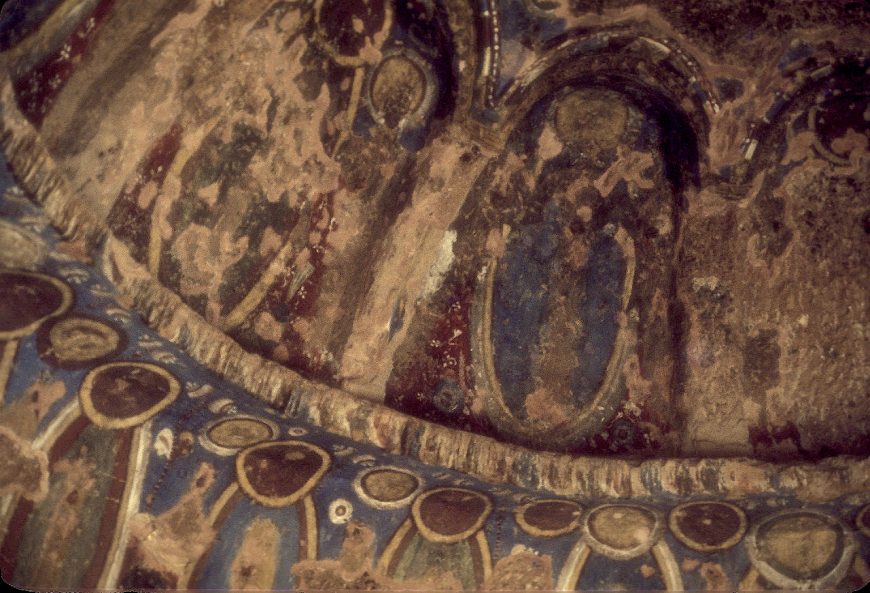
Mural in one of the newly-discovered grottoes (photo: Jerrye and Roy Klotz, MD, CC BY-SA 3.0)
The destruction of the Bamiyan Buddhas was a huge loss for our understanding of human history. However, even in darkness light has a way of emerging. Since their destruction, several new discoveries have been made near the sites of the Bamiyan Buddhas including the discovery of fragments of a 62-foot long reclining Buddha, as well as several caves with murals that may be the world’s earliest examples of oil paint.
As the UNESCO 2017 report states, “the Bamiyan World Heritage property should be considered a place of collective identity and memory, particularly for the local communities; the archaeological remains cannot be separated from their natural and cultural landscape nor from local perspectives.”
Backstory by Dr. Naraelle Hohensee
Notes:
[1] Takayasu Higuchi and Gina Barnes, “Bamiyan: Buddhist Cave Temples in Afghanistan,” World Archaeology, volume 27, number 2, Buddhist Archaeology (October, 1995), pp. 282–302.
[2] Llewelyn Morgan, Buddhas of Bamiyan: Wonders of the World (Cambridge, MA: Harvard University Press, 2012), p. 7.
[3] Xuanzang, The Great Tang Dynasty Record of the Western Regions, translated by Li Rongxi (Berkeley: Numata Center for Buddhist Translation and Research, 1996), p. 38.
[4] Deborah Klimburg-Salter, The Kingdom of Bamiyan: Buddhist Art and Culture of the Hindu Kush (Naples and Rome: Instituto Universitario Orientale and Instituto Italiano per il Medio ed Estremo Oriente, 1989), pp. 87–92.
[5] Finbarr Barry Flood, “Between Cult and Culture: Bamiyan, Islamic Iconoclasm, and the Museum,” Art Bulletin, volume 84, number 4 (December, 2002), p. 648.
[6] Constance Wyndham, “Reconstructing Afghan Identity: Nation-building, International Relations, and the Safeguarding of Afghanistan’s Buddhist Heritage,” Museums, Heritage and International Development, edited by Paul Basu and Wayne Modest (New York: Routledge, Taylor & Francis Group, 2014), p. 126.
Additional resources
Cultural Landscape and Archaeological Remains of the Bamiyan Valley (UNESCO)
UNESCO list of World Heritage Sites in Danger
Unesco video on the Cultural Landscape and Archaeological Remains of the Bamiyan Valley
“Taliban blow apart 2,000 years of Buddhist history,” The Guardian, March 3, 2001
“Disputes damage hopes of rebuilding Afghanistan’s Bamiyan Buddhas,” The Guardian, January 10, 2015
“Afghanistan’s Buddhas Rise Again,” The Atlantic, June 10, 2015
UNESCO technical meeting and International Symposium on “The Future of the Bamiyan Buddha Statues”

